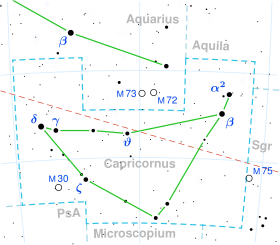Epsilon Capricorni
| Observation data ICRS )
| |
|---|---|
| Constellation | Capricornus |
| Right ascension | 21h 37m 04.83068s[1] |
| Declination | −19° 27′ 57.6464″[1] |
| Apparent magnitude (V) | +4.62[2] |
| Characteristics | |
| Spectral type | B2.5 Vpe[3] |
| U−B color index | −0.64[2] |
| B−V color index | −0.19[2] |
| Variable type | γ Cas[4] |
| Absolute magnitude (MV) | −3.03[5] |
| Details | |
| ε Cap A | |
Myr | |
| Database references | |
| SIMBAD | data |
Epsilon Capricorni,
apparent visual magnitude of 4.62.[2]
In
Chinese name for ε Capricorni itself is 壘壁陣二 (Lěi Bì Zhèn èr, English: the Second Star of Line of Ramparts.)[14]

The binary system has an
emission lines in the spectrum. This circumstellar shell is inclined by 80° to the line of sight from the Earth.[6] The system is undergoing both short term and long term variations in luminosity, with the short period variations showing a phase cycle of 1.03 days.[4] It is classified as a Gamma Cassiopeiae variable with an amplitude of 0.16 in magnitude.[4]
Epsilon Capricorni Aa is a blue-white hued
oblate shape with an equatorial bulge that is 7% larger than the polar radius.[7]
The system has two visual companions. Component B is a visual magnitude 10.11 star at an
arc seconds along a position angle of 46°, as of 2013. Component C with visual magnitude of 14.1 lies at an angular separation of 62.7 arc seconds along a position angle of 164°, as of 1999.[12] Both stars are likely to be unrelated and at different distances to Epsilon Capricorni.[16]
References
- ^ S2CID 18759600.
- ^ doi:10.1086/112600.
- ^ Bibcode:2000IBVS.5008....1A.
- ^ Bibcode:2002JAD.....8....1B.
- ^ S2CID 119257644.
- ^ S2CID 120167606, 82.
- ^ S2CID 119273474.
- S2CID 118629873.
- Bibcode:2004yCat.4027....0K.
- Centre de Données astronomiques de Strasbourg, retrieved 2017-05-15.
- S2CID 14878976.
- ^ doi:10.1086/323920, retrieved 2015-07-22
- ISBN 978-986-7332-25-7.
- ^ (in Chinese) AEEA (Activities of Exhibition and Education in Astronomy) 天文教育資訊網 2006 年 7 月 7 日 Archived 2011-05-21 at the Wayback Machine
- . Retrieved 29 July 2022.
- S2CID 244398875.
External links
- eps Cap, American Association of Variable Star Observers, retrieved 2017-05-17.
- Kaler, James B. (October 9, 2015), "Epsilon Capricorni", Stars, University of Illinois, retrieved 2017-05-17.

